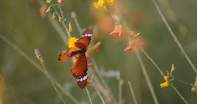

Sometime, somewhere, something is likely to take your head off. If you are a butterfly, it is most likely to come from the air. By the time a butterfly has reached maturity in the shape of a stately butterfly, it has survived 80 - 90 percent of its life's onslaughts already.
But it is not the end, yet. In the larval stage pathogens like fungi and bacteria take their toll too, while another high risk factor is the different parasites.
These come in the shape of many kinds of wasps, sometimes so small that their wingspan measure a 10th of a millimetre!
The wasps lay their eggs in the larvae which then consume the larvae from the inside out.
Hence each stage of the butterfly life cycle is perfectly camouflaged. The eggs may assume the colour of the foliage they are on.
The larvae also do the same or may resemble bird droppings to avoid detection, while the pupa or chrysalis resembles dried or fresh pieces of plant material.
When the perfect butterfly emerges, it is not the end of the line for predators.
For some it may only be the beginning. They have to dodge vehicles, birds, reptiles and other insects. Some have adapted their wing shape to have extra tails on the hindwings.
Butterflies like the Natal bar, (Cigaritis natalensis) which is quite abundant in the KNP, have this trick.

Their tails resemble antenna and a swooping bird mistakes the tail-end for the head and gets away with a mouthful of fluff. Some butterflies when anxious move their hindwings, like a hand-warming gesture, up and down against each other.
This makes the tails tremble adding to the confusion for the over zealous bird. Other birds may go for the head or body, but have their bearings not quite aligned.
With their aim out, they hit the wings. Here it may take off a wingtip or only leave a gap in the wing - a scar that is well worth saving the butterfly's life.
This we can see in the photos of the purple-brown hairstreak (Hypolycaena philippus philippus) having its wingtips sheared and the African common white (Belenois creona severina) with a deep 'v' where a beak would have been.
It's like surviving Jurassic Park all over again. Butterflies have compound eyes that are very sensitive to movement, not only from the air, but from land too. Here they have to be aware of lizards, chameleons, spiders and mantids.
All lie in wait with only a morsel on the mind. Usually they are on or near flowers, where butterflies stop in for a bit of nectar. If the butterflies are too intent on watching the flowers, life for them will be short-lived too. Like the scarlet tip taken by a mantid.
Although, judging by the butterfly's haggard appearance, it has had a good innings and it serves to feed the circle of life. Life is not easy at the bottom of the food chain.
No wonder Africa has some of the fastest butterflies. It's a question of survival. Fight, or flight - very fast indeed.
By Herbert Otto

 There are several butterflies that occur throughout the Kruger National Park and also many that occur throughout the year. Granted, these bu...
There are several butterflies that occur throughout the Kruger National Park and also many that occur throughout the year. Granted, these bu...